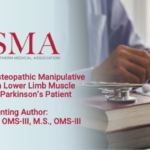Abstract | October 29, 2020
The Effect of Osteopathic Manipulative Treatment on Lower Limb Muscle Rigidity in a Parkinson’s Patient
Learning Objectives
- Describe how this case study has further helped demonstrate how OMT can help with muscle rigidity in Parkinson’s patients.
- Identify which two osteopathic techniques were most effective in this study at helping relieving muscle rigidity in this Parkinson’s patient.
Introduction: Parkinson’s disease is a progressive neurodegenerative disease that imposes a serious mental, physical, and emotional toll on a patient’s well-being. The primary treatment for PD is dopaminergic drugs that help treat motor dysfunction [1]. However, continuous use of these drugs over long periods of time can lead to serious adverse side effects and do not treat the non-motor symptoms of the disease [1]. Osteopathic manipulative treatment (OMT) has been explored as an alternative, non-invasive treatment for patients with Parkinson's Disease (PD). OMT itself is effective at decreasing pain, increasing the range of motion of rigid joints, improving posture, gait, and balance [2]. Accordingly, previous studies have demonstrated that OMT has a positive effect on gait, balance, and motor function in PD patients [2, 3, 4]. OMT’s specific effect on PD patients with lower limb muscle rigidity has been minimally researched. OMT provides a holistic approach to PD and is a safe non- invasive treatment with minimal side effects. Considering its potential benefits and limited research, OMT needs to be investigated further as a valid therapeutic option for patients with PD.
Case Presentation: Our patient was a 65-year-old- Caucasian male. The patient was seen over multiple visits, typically scheduled 2- 3 weeks apart. Upon arrival, the patient was unambiguously restricted in mobility. He presented initially with stabbing pain and stiffness in the right foot, ankle, and Achilles tendon. Pain scale and range of motion were assessed at the beginning of each visit. He reported localized numbness, tingling, and that the pain was worse during ambulation. Physical exam revealed limited range of motion in dorsiflexion of the right ankle. Erythema and edema were documented around the right ankle. The patient had a tailored medication regimen for PD in addition to blood pressure medication. Primary osteopathic treatments targeting the rigidity included muscle energy and articulatory techniques. Myofascial release, balanced ligamentous tension, direct inhibition, and cranial manipulation were used for other somatic dysfunctions. Pain scale and range of motion were assessed after each visit at the beginning of the following treatment. Pain scale, goniometer assess right ankle dorsiflexion, and subjective information from the patient were the primary means of data collection. Data was recorded on the patient’s medical charts, which have been retrospectively analyzed and interpreted.
Final/Working Diagnosis: During the initial visit, the patient rated his pain a 2/10. The range of motion assessed of the right ankle was severely restricted compared to the left. Measurement with a goniometer showed 9-10° dorsiflexion of the right ankle prior to treatment. Immediately after treatment dorsiflexion improved to 20°. During the second visit, the patient reported 0/10 pain and felt a significant improvement in function of his right lower extremity after his previous visit. Initial goniometer assessment showed 18° dorsiflexion prior to treatment, indicating his original treatment had maintained his range of motion. On his subsequent follow-up visits, the patient stated the pain had completely resolved and that he was able to begin exercising without restrictions originally caused
by his right ankle.
Management/ Outcome/and or Follow-up: This case demonstrates that OMT is a beneficial adjunctive treatment for patients experiencing muscle rigidity caused by PD. The patient experienced resolution of pain, increased range of motion and improved function in the lower extremity. Hence, OMT should be considered a viable treatment option for patients experiencing muscle rigidity from PD. Limitations of this study exist, including a case study design and subjective data. However, past studies corroborate our findings. For example, Wells et al. (1999) demonstrated that using ME and articulatory techniques improved stride length, limb velocity, and upper extremity swing [3]. The benefits experienced by this patient and supporting literature warrant future studies with a larger sample size to validate OMT and its use in PD.
References:
- Stoker TB, Torsney KM, Barker RA. Emerging Treatment Approaches for Parkinson's Disease. Front Neurosci. 2018;12:693. Published 2018 Oct 8. doi:10.3389/fnins.2018.00693
- Goldfinger, OMS III, M. S., S. Moriarty, OMS III, K. DelPlato, BS, S. C. Yao, DO, A. Leder, DO, and J. D. Mancini, PhD, DO. “An Osteopathic, Non Pharmacologic Approach to Parkinson’s Disease, Restless Leg Syndrome & Essential Tremor”. Osteopathic Family Physician, Vol. 9, no. 6, 1, https://ofpjournal.com/index.php/ofp/article/view/525.
- DiFrancisco-Donoghue J, Apoznanski T, de Vries K, Jung MK, Mancini J, Yao S. Osteopathic manipulation as a complementary approach to Parkinson's disease: A controlled pilot study. NeuroRehabilitation. 2017;40(1):145-151. doi:10.3233/NRE-161400
- Wells MR, Giantinoto S, D'Agate D, et al. Standard osteopathic manipulative treatment acutely improves gait performance in patients with Parkinson's disease. J Am Osteopath Assoc. 1999;99(2):92-98. doi:10.7556/jaoa.1999.99.2.92

